So, there I was in the back seat of my friend John Smith’s 1969 Mercury Cougar. The car was nine years old by then; it was late 1978. I was twenty-two years old. I’d met John (“Butch” to his friends) when I was fifteen years old. He was playing at a legendary joint called the Pizza Palace in Huntington Beach, California. The South Frisco Jazz Band played there every weekend, and it was THE hangout for several of my high school friends and me. The night I met John, he was subbing for clarinetist/saxophonist Mike Baird, still a personal hero of mine.
John must have been about thirty or thirty-one then. He quickly became another of my heroes, both musically and personally. I began trying to swing on the trombone and cornet like he did on soprano and alto saxes, and strived to be a polite, classy guy like him. (I’m still trying.) John is eighty-three years old at this writing, but back in those halcyon days we played often together in various bands around southern and northern California. We also traveled together to Europe several times; mostly to perform at the Breda Jazz Festival in the Netherlands—and around Germany—with a hotter-than-hell jazz band called the Sunset Music Company. John also performed there as a member of George Probert’s Happy Riff Machine. (Our Dutch friends quickly dubbed the band the “Happy DRINKING Machine,“ but that’s another story…)
John’s presence on the bandstand accounted for much of the heat both bands generated. Another contributor to either band’s “sizzle quotient” was cornetist Jim Goodwin. No one played more soulfully, or swung more than Jim, whether he was on cornet or piano. One of the greats, man.
On this occasion, Jim was up in front next to John, riding shotgun. I was in the back seat, glad to be with two of my favorite people on earth. I idolized these two guys.
I don’t recall where we had just been, or even why we were now driving around in the Hollywood Hills! (John still lives in Littlerock, California. Littlerock is in the Mojave desert, about an hour northeast of Los Angeles. Jim, who died in 2009, was down south visiting from Berkeley, his home at that time). I remember we were headed back to John’s place from wherever we had been in Los Angeles. It had started raining, and John was making his way on narrow rain-slicked roads, the street signs becoming harder to read as it became later in the day and the sky grew darker. Now we were in the Hollywood Hills.
John always had music going in his car. It was the era of dash-mounted cassette players. John would make what we called “road tapes.” They were compilations selected from his extensive— and choice— collection of LPs and 78 rpm records. (Compact discs hadn’t yet made the scene). Billie Holiday was singing “Getting Some Fun Out Of Life.” I was digging Lester Young’s tenor sax work behind her.
John broke the mood. “Ah, crap! I thought this street would get us back down to the freeway…”
I saw Goodwin look over at him. Jim turned Billie’s volume down for a second, and said, “Hey, man! Don’t worry; we’ll find it.” He quickly returned Billie to her normal level.
Jim had on his Brooks Brothers seersucker jacket, worn with tired (but clean) blue jeans. On his feet, he wore black-and-white Converse high-top sneakers, long before those shoes became “hip” footwear. The jacket came from a Berkeley thrift store, but you’d never know it. It looked brand new, and as though it had been tailored for him. Jim was so cool, he made Steve McQueen look uptight.
John replied, “Yeah, I guess we’ll find it eventually.” Then he blurted, “Hey, Jim! Doesn’t Jess live around here someplace?”
Jim’s eyebrows arched into chevrons. “Uh, yeah, I think so…Ray said he lived ‘somewhere in the Hollywood Hills…’”
Jim was referring to Seattle-based pianist Ray Skjelbred. (Need I say it? Yet another hero.)
“Hey, man,” I said. (We said “hey, man” a lot to each other.) “You said, ‘Jess.’ Like, I mean, Jess who?”
John said, “Jess Stacy.”
“Jess STACY?!”
“Yeah…wait a minute…” John went on, distracted. “I think Ray said he lived on Lookout Mountain Road…”
“Yep, that’s the street all right,” said Goodwin.
Just then, John rounded a corner, and his headlights landed on a green street sign.
“Ha! Look at that! Lookout Mountain Road!”
Jim chuckled, and said, “Well, maybe we should drop in and say hello.”
John said, “That’s just what I was thinking. OK, Barrett: start looking at the mailboxes. You, too, Jim. Maybe we’ll get lucky.”
As I scanned the mailboxes we were passing I said, “Hey, guys. Do you think this is a good idea? I mean, it’s JESS STACY! We can’t just walk up and ring his doorbell, uninvited!”
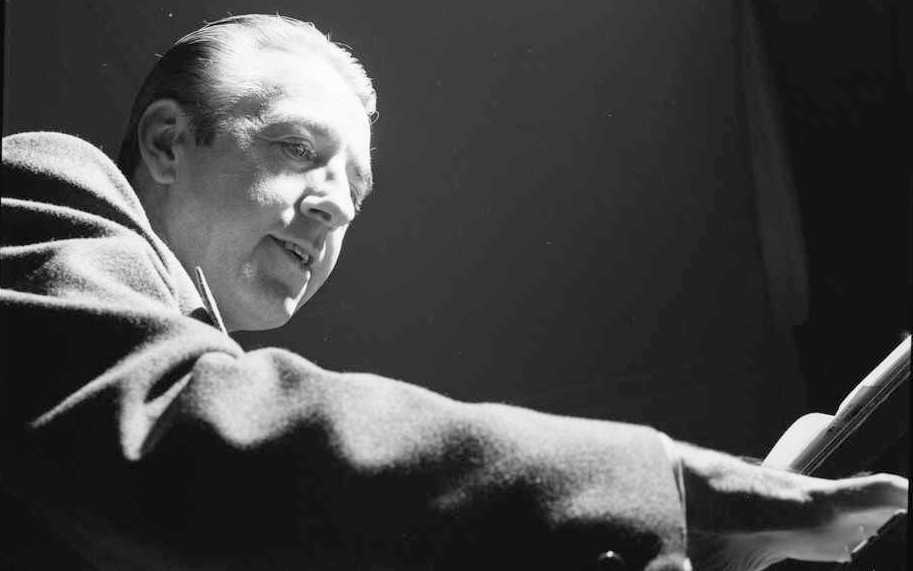
Smith glanced at me in the rearview mirror. He smiled and said, “Well, why the hell not? It’s true he doesn’t know us, exactly, but I know he’s been in touch with Ray. They’re buddies. We’ll just tell him we’re friends of Ray’s. Don’t you want to meet him?”
Before I could answer, Jim said, “John! Look up ahead. That little red mailbox…says ‘Stacy’ on the side…”
I peered around Jim’s shoulder, and saw the mailbox. It had STACY painted on its side in large white capital letters. The hand-painted letters on the side of the brick-red wooden mailbox looked rustic. The mailbox could have been a prop from The Real McCoys television show. The Stacys and the McCoys.
John pulled to the curb and parked right in front of a small rose-pink house with a small, square, well-tended front yard. A tidy little garden formed two narrow rectangles along the house, on either side of the concrete porch. We got out, and hurried through the rain up onto the porch. We huddled under an aluminum awning as John reached out and rang the doorbell. It was dark by now, and raining pretty hard. None of us had shaved for a couple of days. Too busy having fun. John was wearing old brown corduroy pants and a white T-shirt that had HUDSON HORNET air-brushed in colorful, cartoonish lettering on the front. A nice rendering of a ’51 Hornet was under the writing. (John still has a Hudson in his garage at home. I think it’s a ’46 Commodore coupe, but I’m not sure.)
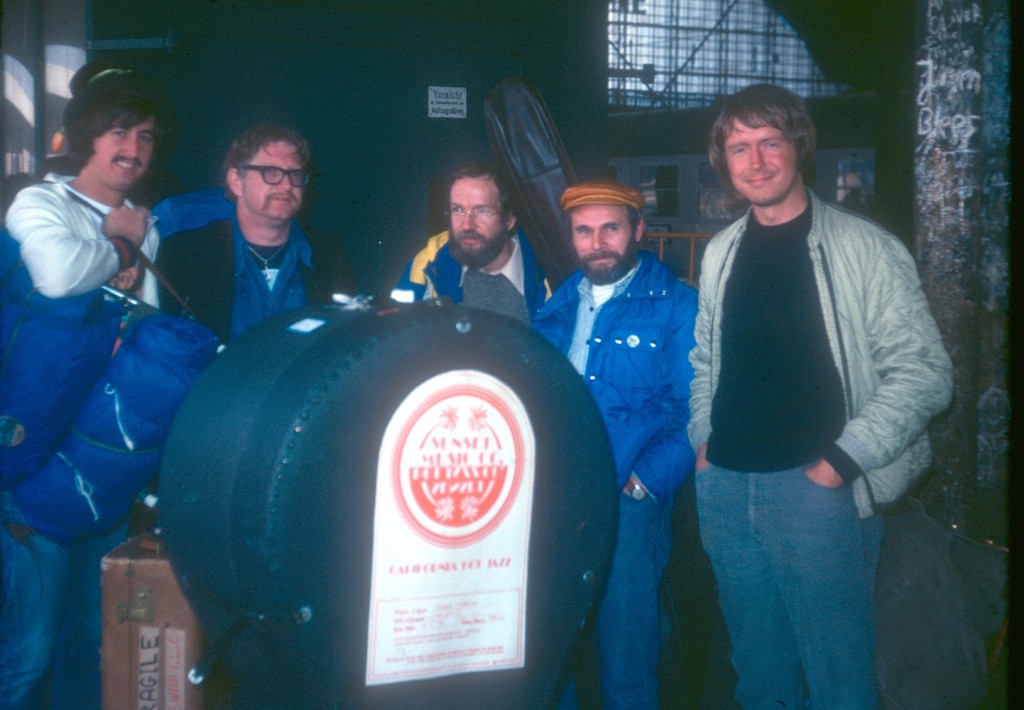
I probably had on a plaid flannel shirt and jeans. Dirty sneakers. I hadn’t yet found a used Brooks Brothers seersucker jacket like Jim’s, but I was still looking. Jim looked as though he were dressed for success, but basically John and I looked like bums.
The front door opened, and a pleasant, not-unattractive older woman was looking through a screen door at us. She smiled, but looked ever-so-slightly suspicious.
“What can I do for you boys?”
John spoke up. “Good evening. You must be Mrs. Stacy. My name is John. This is Jim, and Dan. We’re musicians; friends of Ray Skjelbred’s. I hope we’re not imposing, but…well, we were literally in the neighborhood, and thought we’d drop by to say hello to Jess. Is it possible to see him?”
Mrs. Stacy looked at us again, and said, “Please call me Pat. Wait here, fellows.”
She disappeared, and much to my amazement, we heard her shout, “Oh, Jess! Some boys are here to see you. They’re friends of that pianist you know up north, Skjelbred…”
We heard some shuffling, and suddenly there he was. Jess Stacy appeared right in front of us! He wore reading glasses perched precariously at the end of a rather generous nose. The glasses had a thin link chain that went around the back of his generous neck. I noticed a paperback book in his left hand, his index finger marking a page. Stacy’s thinning brown-and-gray hair was a little mussed, and he was wearing a sky-blue bathrobe over red-and-white striped pajamas. I think the PJs also had a groovy, narrow metallic gold stripe in them. He had on fluffy, comfy-looking slippers with little furry gray bunny rabbits on the toes. Little bunny rabbit eyes and ears. Incredible.
He smiled at the three of us, and said, “Hi, guys! You say you’re musicians? Friends of Ray’s?”
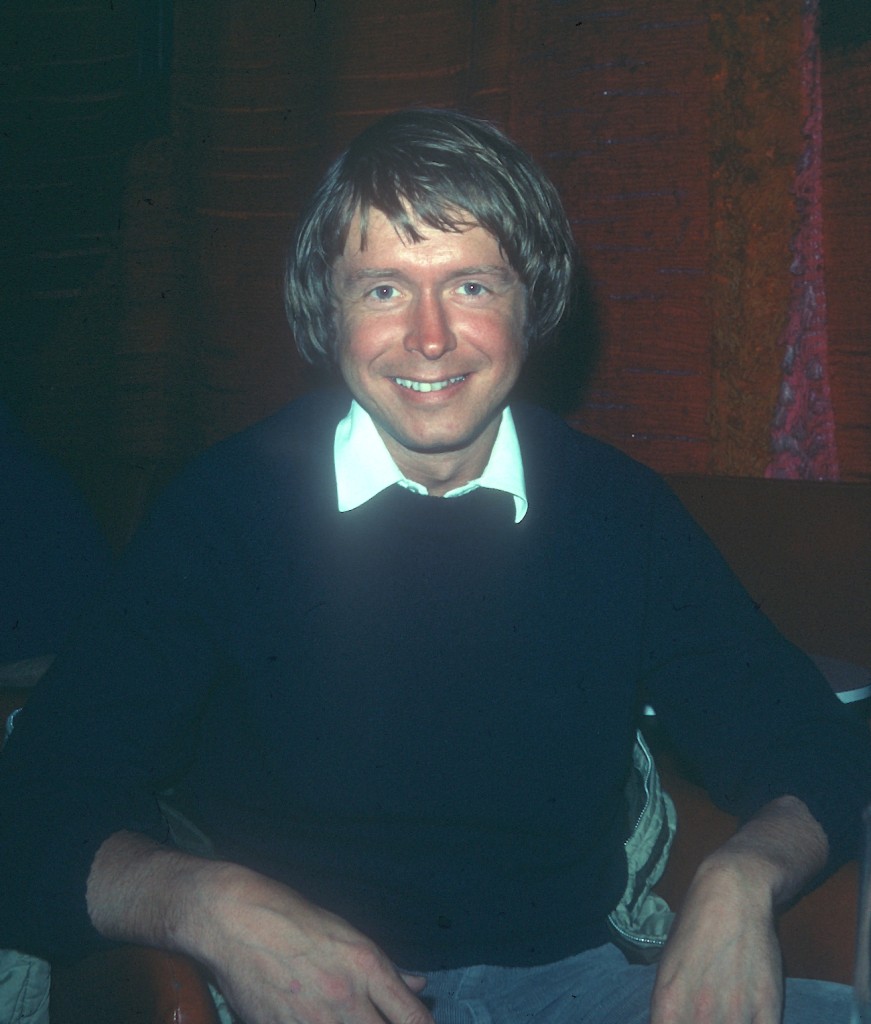
“Yes, sir.” Goodwin answered this time. I’m glad he did. I couldn’t say or do anything. Jim continued. “We’re on our way out to the desert, where John lives, but we remembered you lived around here. Ray told us. We…just wanted to say ‘hello.’” If it’s not convenient, we’ll be on our way.” Jim’s smile was very engaging.
Then Jess looked past us at the dark sky, and the rain. “Oh, my goodness! It’s raining! Please, hurry—come in, come in…”
He opened the screen door, and stood aside as we filed into a well-kept living room.
“Have a seat,” he said. “Can I get you boys something to drink?” He set the book he’d been reading on an old metal TV tray. The tray was white, with red roses in its recessed middle; a gold border; and narrow brass legs. My mother had its twin in her living room.
John, Jim, and I looked at each other. We were speechless. Here we’d just barged in on one of the greatest piano players in all of jazz, and he’s offering us drinks. You could have knocked us over with a feather, Leonard.
Jess continued. “I have all kinds of soda pop. I also have beer in the ’fridge.” I quit drinking around 1965, but I keep some beer around for guests. Would you fellas like a beer?”
A few minutes later, the three of us were drinking cold beer. Jess had a Coke with us.
We all faltered nervously, trying to converse. Then I said, “Mr. Stacy, please tell us about your time with Benny Goodman.”
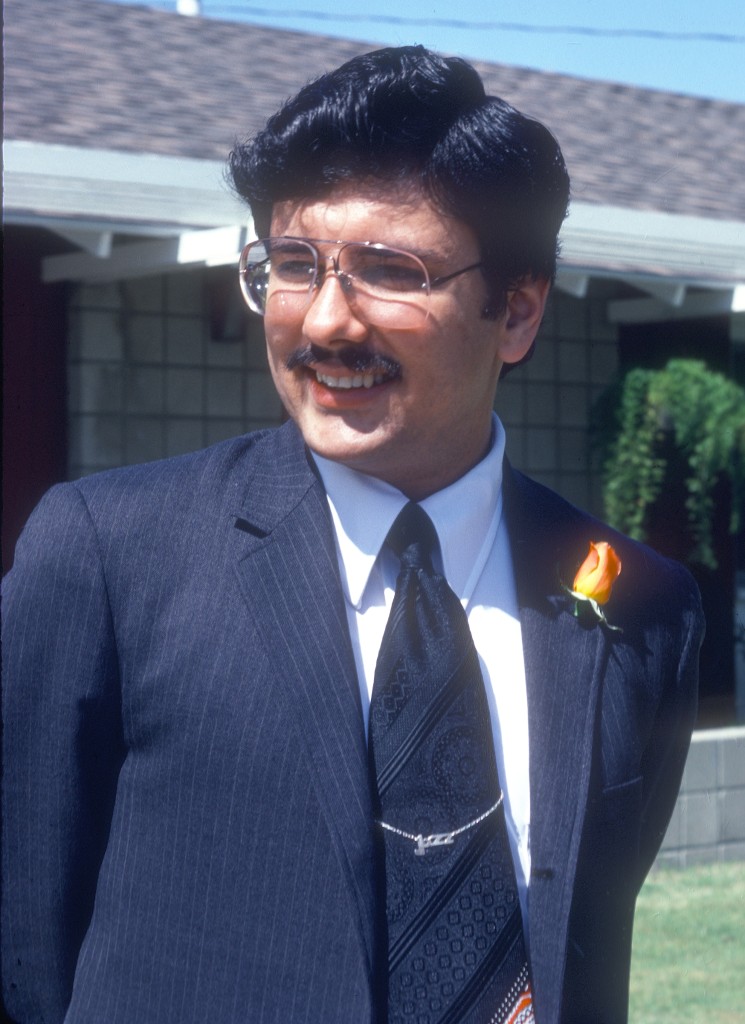
He looked at me without expression, and then thankfully he smiled. “Everyone asks me about Benny, as though I had no life before or after those years. But…you’re young. It’s OK. Danny, right? That’s your name?
“Well, Danny, it was an exciting time, all right. Benny had…funny ways, and he could be a real jerk sometimes. Then there would be those nights when he was swinging so great, you’d forgive everything he said or did. ’Course, that rhythm section we had helped make it all happen.”
Jess was remembering drummer Gene Krupa; bassist Harry Goodman (Benny’s talented brother) or maybe bassist Artie Bernstein, and rhythm guitarist Allan Reuss, who has never received enough credit for his important contribution to Goodman’s terrific 1937 rhythm section. John and Jim peppered Jess with more questions about Goodman, the band, Jess’s sessions with Lionel Hampton for RCA Victor, and other guys Jess had played with over the years. Jess politely fielded all the questions, and seemed to enjoy the memories they were bringing back.
During a brief lull, Jess thought for a moment. “Hey, guys,” he said. “Get up! Come on…follow me.”
Jess yelled out, “Pat? PAT! Where’s the damn flashlight?”
Mrs. Stacy came out of a bedroom holding a large old flashlight. She handed it to Jess. He said, “Thanks, honey.”
She smiled at us and disappeared back into the bedroom.
Jess said, “Follow me.”
We fell in line behind him, and he led us to a hallway connecting the living room with the back of the house. He clicked on the flashlight, and pointed it at a framed photo hanging chest-high on the left wall.
“Look at this!,” he said. “You won’t see this one in any of those ‘jazz books.’ It’s one of a kind!”
The three of us gathered around Jess and peered at the photo. It was of the Goodman band, at the Steel Pier in Atlantic City. 1938. The photo looked posed, and the band was either just about to start a set, or end a set. Or, maybe they were in between numbers. The brass section was standing; saxes sitting. Harry James and Ziggy Elman were visible in the trumpet section, and tenor saxophonist Bud Freeman was there, with dark hair! Dave Tough was behind his drum set, surrounded by cymbals. Stacy sat at a grand piano, looking quite relaxed, his left arm resting above the keyboard, on the music rack. Benny was out front, of course, in a white suit and dark tie. There looked to be hundreds of curious swing fans in front of the high stage.
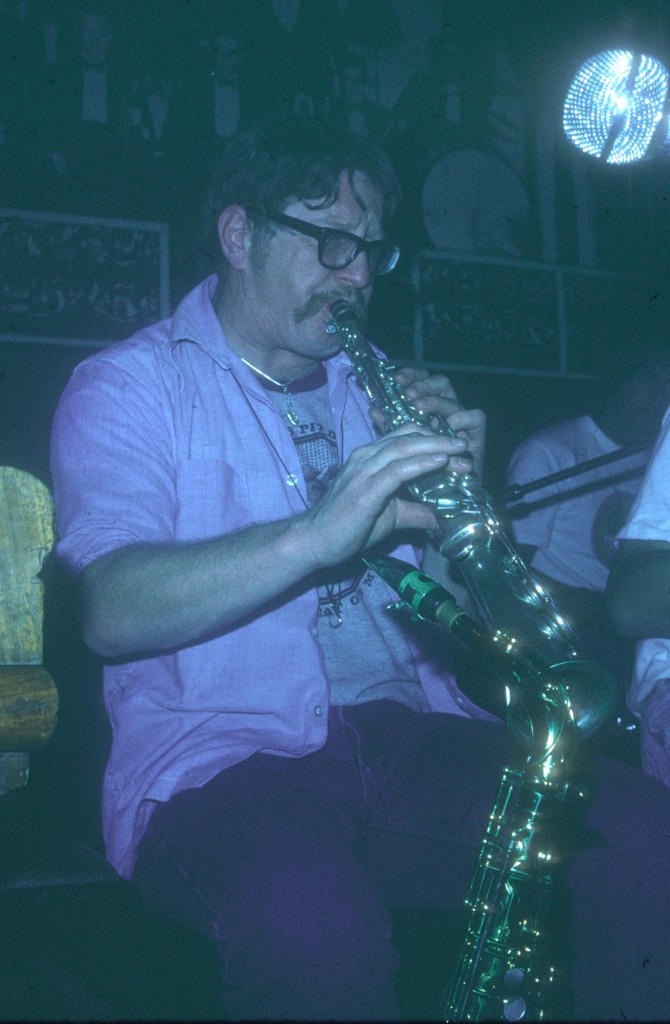
I’d seen a similar shot in a couple of books, but not this particular one. It was taken from a different angle, and the band was posed slightly differently. It was magic to see this different view of a familiar photo, like hearing an alternate take of a well-known recording.
Jess aimed his light further down the dark hallway and took a few steps. We were right behind him.
“Here’s Gene and me.” It was another terrific photo; a close-up of Krupa and Jess on the bandstand, both young and smiling, knowing they were playing with one of the top bands in the country, and one of the swingingest!
There were a few other photos on either side of the hallway. Jess showed us each one, and patiently stood there with the flashlight as we oohed and aahed. Finally, he clicked off the light, and led us back to the living room. John, Jim, and I sat down again. Jess went into the kitchen and came out with three more beers. He handed one to each of us. He looked at me. “You sure you’re old enough?,” he said. Then he laughed quietly, and winked at me. He went on.
“I loved drinking, but finally had to give it up. I was playing solo piano in different bars and clubs. Some were real ‘buckets of blood!’ It got to be I’d be checking my watch, counting the minutes ’til I could go to the bar and get a drink. I was a mess, but finally managed to quit the sauce. A lot of my friends weren’t so lucky. Watch that stuff, guys. It’s fun and all, but…it has a way of sneaking up on you.”
We all nodded in understanding, looked at our beer, and sipped a bit more discreetly.
I don’t remember much more of what we talked about. Jess mentioned hearing Earl Hines in Chicago in the 1930s, and what an impact Hines had on the other piano players in town, including Jess. We got around to talking about Ray Skjelbred.
“Like me, Ray got a few things from Hines. I was surprised when I first heard Ray play. It’s kind of…weird, hearing a guy playing a little like I do!” Jess stopped, and look at each of us in turn.
“Hey, it just occurred to me…Ray sent me a record he made down here in Los Angeles. The band had an odd name… not the ‘Charleston Chasers’; wait a minute.”
We could see him trying to come up with the name.
“…Funny name…about chasing something…”
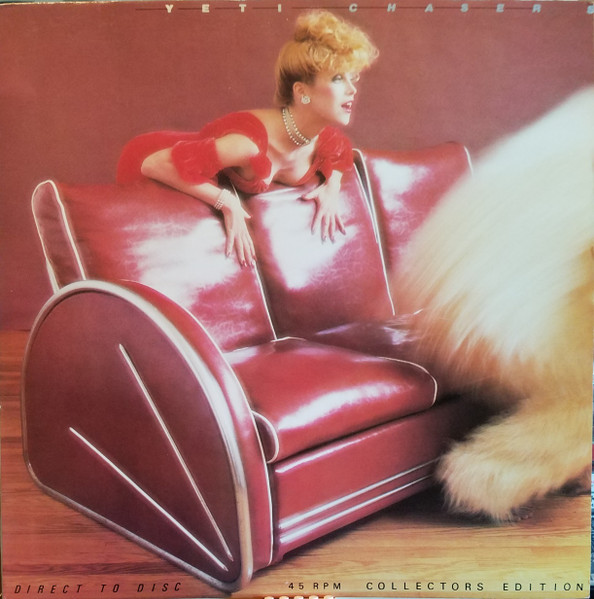 With some effort, he got up out of his chair again, and went over to a small row of LPs, in a corner by a 1960s radio-turntable console. He flipped through the discs and said, “Yeah! This is it!”
With some effort, he got up out of his chair again, and went over to a small row of LPs, in a corner by a 1960s radio-turntable console. He flipped through the discs and said, “Yeah! This is it!”
He looked at the cover. When he held it up, John and Jim and I looked nervously at each other. Jess brought up his reading glasses. Down on his slippers, the bunny rabbits’ ears were twitching.
“The YETI Chasers! That’s the name! I had to ask Ray about it. He said ‘yeti’ is another name for Bigfoot; some kind of big creature that lives in the forest or something. Hell, I don’t know.
“But, wait a minute!” He looked at the back of the album again.
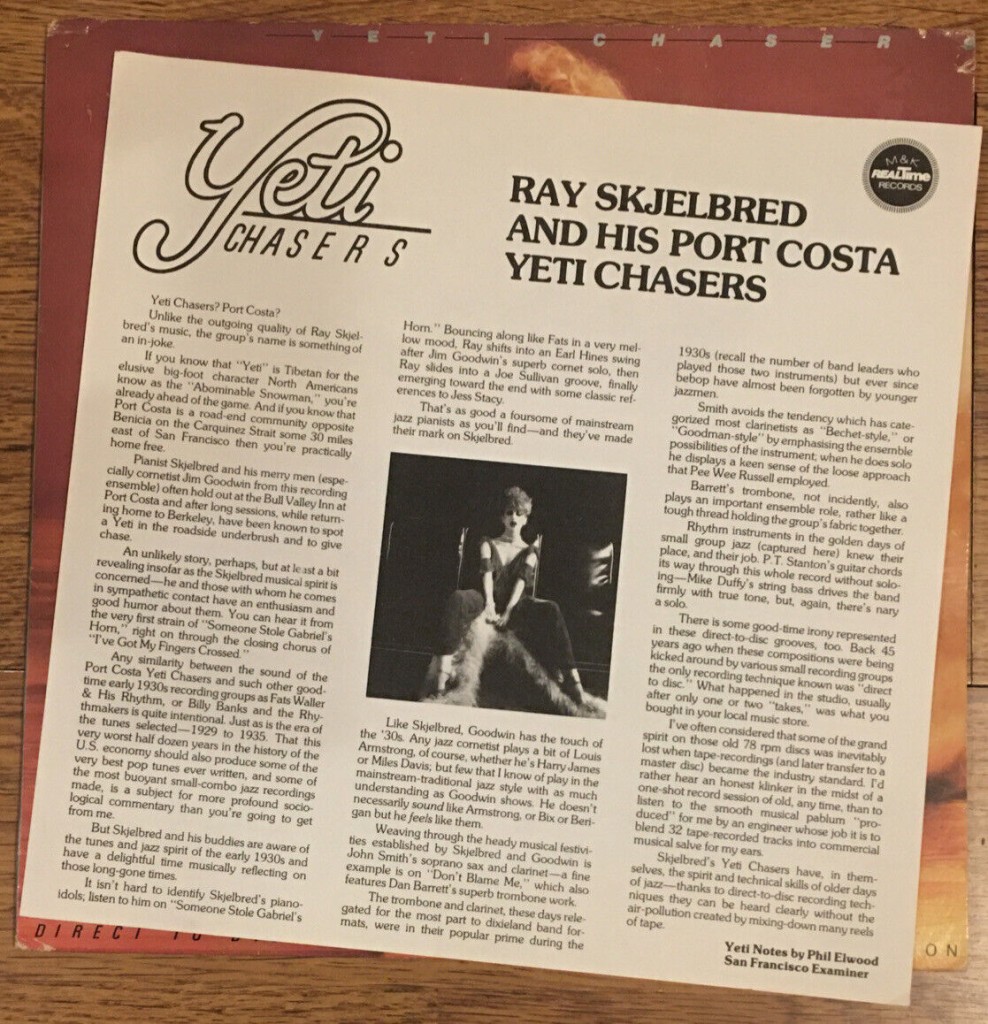 “John…Jim…Dan…hmmm…It says here, John Smith, Jim Goodwin, Dan Barrett…hmmm…Mike Duffy, bass…Jeff Hamilton, drums…P.T. Stanton, guitar…
“John…Jim…Dan…hmmm…It says here, John Smith, Jim Goodwin, Dan Barrett…hmmm…Mike Duffy, bass…Jeff Hamilton, drums…P.T. Stanton, guitar…
“So, you’re John…and Dan…and Jim. You’re the guys on this record?”
We sheepishly admitted we were.
“Ha!” Jess said. “How ’bout that! PAT!” Jess shouted. Pat emerged from the bedroom.
Jess said, “Will you look at this? These three boys are all on this record that Ray sent us!”
I was thinking that Jess Stacy is on hundreds of great recordings, including many that are considered jazz classics. But here he was, seemingly excited about three little-known guys on a recent small-batch release.
Side Note:
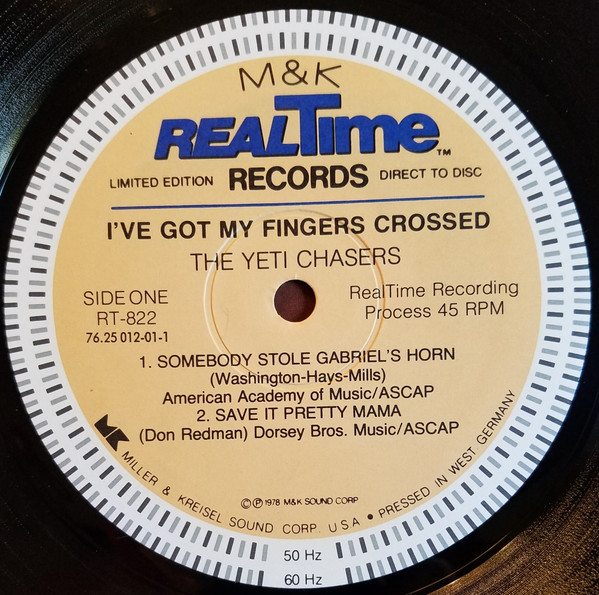 We had recorded it at the behest of the legendary (and still active) cornetist Leon Oakley (yes, a hero), who made his bones playing with Turk Murphy’s great band of the 1970s and ’80s. Leon produced the recording, which was for M&K Records. The unusual thing about the record was that it was recorded “direct-to-disc.” This was a fad in the mid-1970s, aimed at the burgeoning audiophile market. The discs played at 45 rpm, as opposed to the standard 33 1/3 of LPs. The bugaboo about it all was that each side of the disc had to be recorded in one take, and there was no possibility of editing or mixing after the fact.
We had recorded it at the behest of the legendary (and still active) cornetist Leon Oakley (yes, a hero), who made his bones playing with Turk Murphy’s great band of the 1970s and ’80s. Leon produced the recording, which was for M&K Records. The unusual thing about the record was that it was recorded “direct-to-disc.” This was a fad in the mid-1970s, aimed at the burgeoning audiophile market. The discs played at 45 rpm, as opposed to the standard 33 1/3 of LPs. The bugaboo about it all was that each side of the disc had to be recorded in one take, and there was no possibility of editing or mixing after the fact.
The Yeti Chasers played two tunes on each side of the disc. We’d finish the first tune, remain silent for a few seconds, and then go into the second tune. I remember you can hear the piano bench squeak a bit in between tunes on one side of our disc. It was rather like recording a 78rpm disc, but in ultra hi-fi and at 45rpm, and two tunes at once instead of just one at a time!
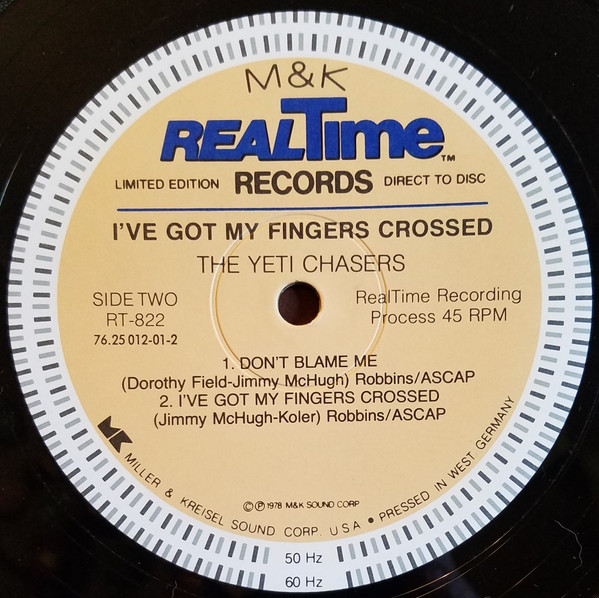 A tenor saxophonist named Bert Noah was also at the session, and recorded a couple of songs with us. Unfortunately, those tunes couldn’t be used, because of technical problems and time constraints. Bert was a good, swinging player who had played with Jack Teagarden’s big band in the 1940s. He too was a member of the early Happy Riff Machine, and loved the Breda Jazz Festival and the Dutch people as much as the rest of us.
A tenor saxophonist named Bert Noah was also at the session, and recorded a couple of songs with us. Unfortunately, those tunes couldn’t be used, because of technical problems and time constraints. Bert was a good, swinging player who had played with Jack Teagarden’s big band in the 1940s. He too was a member of the early Happy Riff Machine, and loved the Breda Jazz Festival and the Dutch people as much as the rest of us.
Harry James’s band made a popular record like this at the time: The King James Version. Like the Yeti Chasers, James was probably glad the fad fizzled out after just a few years. It was simply too stressful, having to record an entire side of a record in one take. And if you “hit a clam” (“played a wrong note,” for you squares out there), you had to either live with it, or make everyone do the whole side over again. Still and all, I’m grateful that Leon Oakley and Ray Skjelbred brought us all together to record that unusual disc. It’s a memorable aural document of a very special, memorable group of people. Several of the band have gone over to the flip side: Goodwin; the great and unique P. T. Stanton; bassist Mike Duffy; and saxophonist Bert Noah… I miss them.
Jess again looked at the cover of our record for a few moments. Then he flipped it over and examined the back. “You know, I played this quite a few times after Ray sent it to me. Pat and I really enjoyed it! Let’s listen to it…” He walked over to the turntable as he started taking the disc out of the sleeve.
We all gently protested, and Jess backed off. He understood. “Ha! I forgot. Now I remember what it was like when all those well-meaning fans would invite me over to their home, and then insist on playing my own damn records for me. I don’t like to listen to myself, either…but you guys should be proud of this one!”
I thought that was kind of him to say. He set the record aside on a nearby TV tray.
We talked a bit more, and then John said, “Jess, I think we’re going to have to leave you. I still have to drive us back to my place in the desert, and the weather isn’t getting any better.”
Pat Stacy came out one last time. John, Jim, and I bade goodbye to both of them.
Jim was putting on his seersucker jacket, and we were getting ready to head out the door.
“Oh, fellas?” Jess asked. “Just a second.” He picked up the Yeti Chasers disc, which he’d set down on the old TV tray.
He held it out in both his hands. I looked again at the reading glasses, now hanging from the chain around his neck, and the blue bathrobe, and those silly rabbit slippers. And I saw one of the true greats of jazz.
Jess said, “Would you…would you mind signing this record for me? I’d sure appreciate it…”
You could have knocked all three of us down with an eighth note. We couldn’t believe it. Jess Stacy, a true jazz legend, and star of Goodman’s 1938 Carnegie Hall concert, asking us for our autographs!
We obliged, of course. I’m sure each of us wrote something sentimental, and attempted to let Jess know how much we thought of his playing and artistry. He thanked us with genuine sincerity. He and Pat told us we were welcome back any time; maybe we’d have dinner together. I wish that had happened, but it wasn’t to be.
It’s a wonderful thing when a hero of yours turns out to be a kind, caring, and modest person. That’s how I’ll always remember Jess Stacy.
Dan Barrett is a professional trombonist/ cornetist, arranger, and composer. He enjoys performing in admittedly old-fashioned jazz styles. He has recorded for Concord Records, Arbors Records, and his own Blue Swing Recordings label, among many other labels. Dan fell in love with jazz in high school, and learned to play from much older musicians from New Orleans, who had settled in the Los Angeles area. He has played at Carnegie Hall five times, and was featured in the last bands led by Swing Era icons Benny Goodman and Buck Clayton. Another highlight of Dan’s musical life—so far—was being a member of Lueder Ohlwein’s Sunset Music Company. Write to Dan at: www.DanBarrettMusic.com.






















